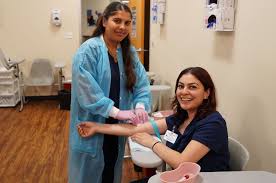Phlebotomy training is essential for anyone looking to pursue a career in healthcare, particularly in roles that require drawing blood from patients. This process is not just about learning how to draw blood but also about understanding the medical procedures involved, maintaining safety standards, and ensuring patient comfort. If you’re considering a career in this field, it’s important to understand the scope of phlebotomy training and how it can open doors to a rewarding profession.
In this article, we will discuss everything you need to know about phlebotomy training, including the skills you’ll learn, the certification process, and tips for success in this field. Whether you’re just starting to explore the profession or you’re ready to enroll in a program, this guide will give you the insight you need.
What is Phlebotomy?
Phlebotomy is the medical practice of drawing blood from patients for various purposes, including diagnostic testing, transfusions, research, and blood donations. Phlebotomists are trained professionals who carry out these procedures with care and precision, ensuring that they follow medical guidelines and safety protocols. Their role is critical in the healthcare industry, as blood samples are often needed to diagnose diseases, monitor health conditions, and provide treatments.
A phlebotomist’s work typically involves interacting with patients, explaining the process, and making them feel at ease. The work requires a steady hand, excellent communication skills, and the ability to stay calm under pressure. Training in this field equips individuals with the necessary knowledge and techniques to handle these responsibilities effectively. Phlebotomy training and workshops provide hands-on experience and expert guidance, helping individuals develop the skills necessary to perform blood draws safely and efficiently in a professional healthcare setting.
Why is Phlebotomy Training Important?
Phlebotomy training is vital for several reasons. First, the procedure of drawing blood is delicate and must be done accurately to avoid complications like infection or improper sample collection. Improper technique can also result in patient discomfort or failed blood tests. A certified phlebotomist is trained to avoid these risks and ensure that the blood is drawn correctly, safely, and hygienically.
Additionally, phlebotomists are required to follow various safety standards, including proper disposal of needles and biohazard materials, understanding patient confidentiality, and maintaining a sterile work environment. Training programs teach all of these aspects, which are essential for both patient and healthcare worker safety.
What Does Phlebotomy Training Involve?
Phlebotomy training typically includes both theoretical coursework and practical, hands-on experience. Some of the key topics covered in phlebotomy programs include:
- Anatomy and Physiology: Understanding the circulatory system, veins, and arteries, which is essential for knowing where to draw blood safely and efficiently.
- Blood Collection Techniques: Learning various methods to collect blood, such as venipuncture and capillary puncture, and how to handle different types of blood specimens.
- Infection Control: Understanding how to maintain a sterile environment, use protective equipment, and dispose of waste materials safely to prevent the spread of diseases.
- Patient Care: Learning how to communicate with patients, calm nervous individuals, and provide proper post-procedure care.
- Legal and Ethical Responsibilities: Knowing the legal aspects of drawing blood, including patient consent, confidentiality, and ethics in healthcare.
Training programs may last anywhere from a few weeks to several months, depending on the program’s intensity and whether you are pursuing a certificate or associate degree. Some training is done in a classroom setting, while the rest occurs in a clinical environment where students can practice their skills on real patients under supervision.
How to Become a Certified Phlebotomist?
To become a certified phlebotomist, you must complete a formal training program and then pass a certification exam. Certification helps to validate your skills and make you a more attractive candidate for employers. In the United States, several organizations offer phlebotomy certification exams, including:
- The American Society for Clinical Pathology (ASCP)
- The National Phlebotomy Association (NPA)
- The American Medical Technologists (AMT)
Each organization has slightly different certification requirements, but most require that you complete a phlebotomy training program and accumulate a certain number of hands-on practice hours. Once you meet these requirements, you can sit for the certification exam, which typically includes both a written test and a practical exam where you demonstrate your skills.
Where Can You Get Phlebotomy Training?
Phlebotomy training can be found in various settings, including community colleges, technical schools, hospitals, and online platforms. It’s important to choose a program that is accredited and recognized by certifying organizations to ensure that you are receiving quality education and that your certification will be valid.
Some hospitals and clinics offer on-the-job training or apprenticeship programs, where you can learn while working. These programs can be a good way to gain experience while earning money, but they may not always provide the same depth of education as a formal training program.
Online training options are also available for those who prefer a more flexible learning environment. However, it’s essential to ensure that any online program includes in-person clinical training, as hands-on experience is crucial in phlebotomy.
What Skills Do You Need to Succeed in Phlebotomy?
Phlebotomy requires a combination of technical skills and interpersonal qualities. Some key skills that will help you succeed include:
- Attention to Detail: Drawing blood involves precision, and even small mistakes can affect the results of lab tests.
- Communication Skills: You must be able to explain the procedure to patients and make them feel comfortable.
- Steady Hands: A phlebotomist needs to be calm, focused, and steady when using needles and other medical instruments.
- Physical Stamina: Phlebotomists may spend long hours on their feet and handle multiple patients throughout the day, so physical endurance is necessary.
- Knowledge of Safety Standards: Understanding how to follow infection control practices and maintain a clean, sterile environment is crucial.
Developing these skills during your training will help ensure that you are prepared for the responsibilities of the job and that you can deliver the best possible care to your patients.
Career Opportunities for Phlebotomists
Phlebotomy training opens the door to various career opportunities. Phlebotomists can work in hospitals, outpatient clinics, blood donation centers, medical laboratories, and even in research facilities. The demand for phlebotomists is growing as the healthcare industry expands, making this profession a stable and rewarding choice.
Additionally, there are opportunities for career advancement. Some phlebotomists move into supervisory roles, while others pursue further education to become medical laboratory technicians, medical assistants, or nurses. The skills learned in phlebotomy training can serve as a strong foundation for further advancement in the healthcare field.
Conclusion
Phlebotomy training is an excellent choice for anyone interested in a career in healthcare. It offers the opportunity to gain valuable skills that are in high demand, while also providing a rewarding job that directly impacts patient care. By completing a phlebotomy program, you’ll be prepared to work in a variety of healthcare settings, confidently draw blood, and ensure patient safety.
Remember that the key to success in phlebotomy training is to stay focused, practice your skills, and continue to learn about new techniques and procedures. With the right education and commitment, you can enjoy a fulfilling career as a certified phlebotomist.



